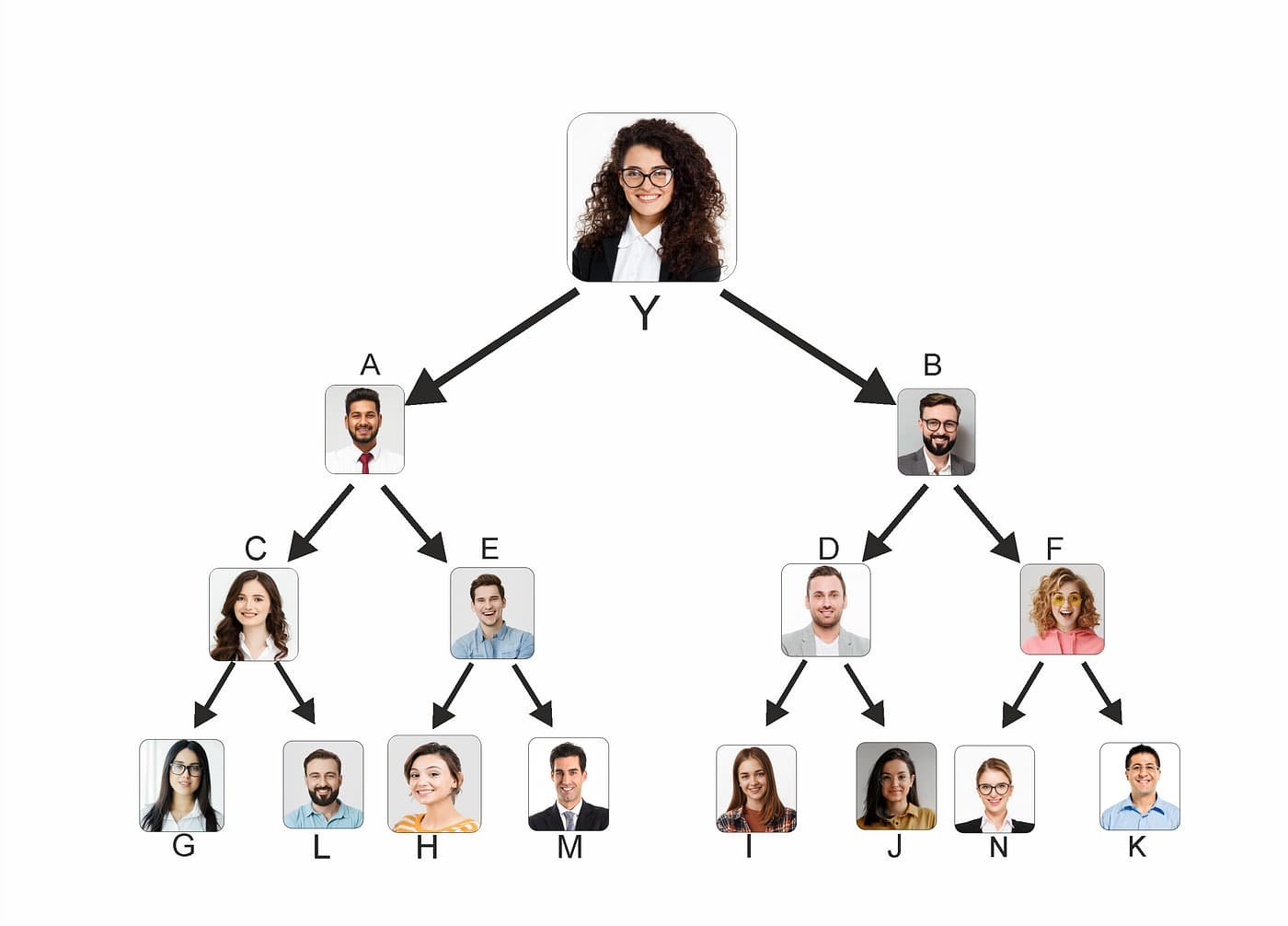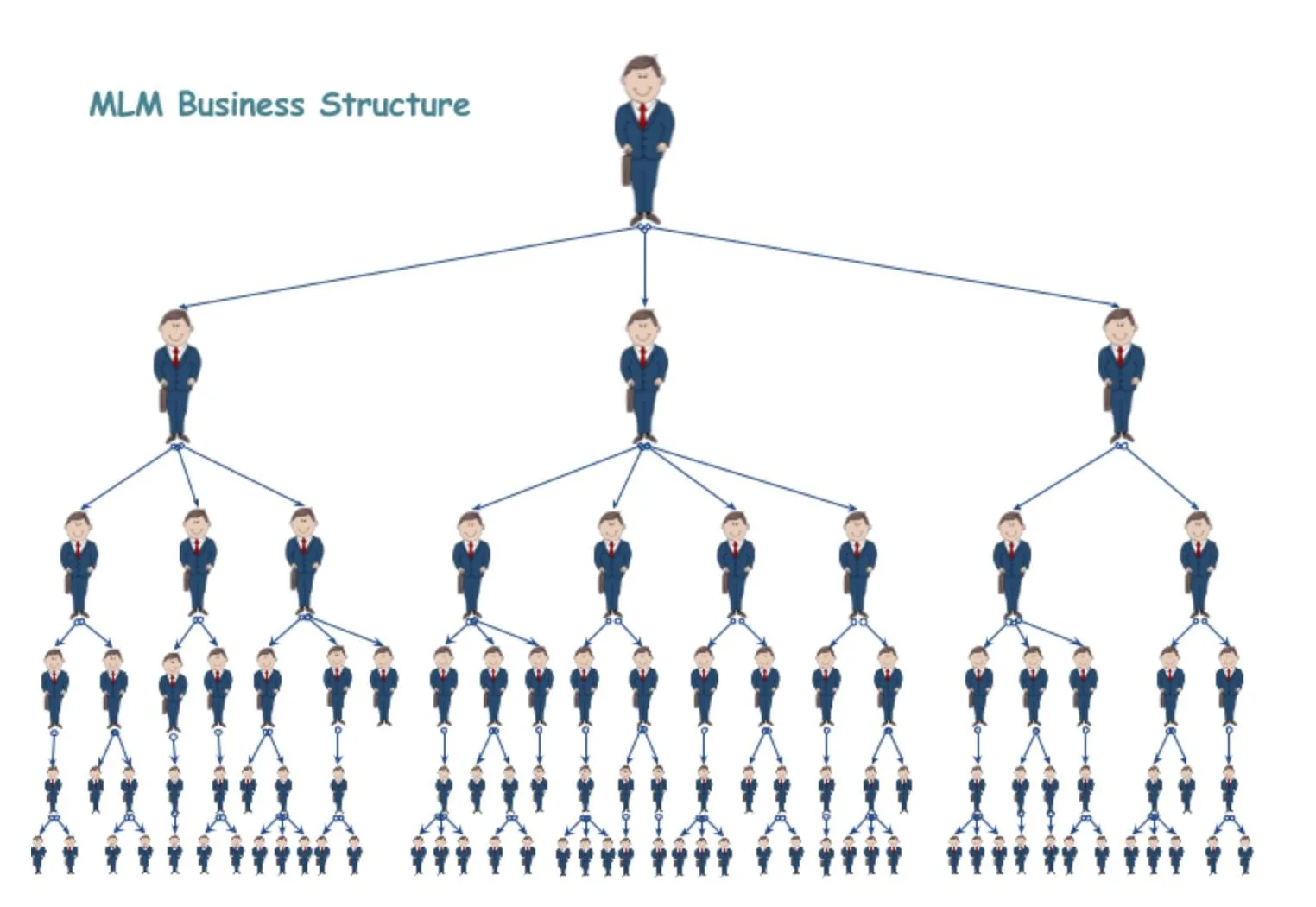Multi-level marketing structures, often referred to as network marketing, is a business model where companies distribute their products or services through a network of independent distributors.
These distributors earn income from their own sales as well as from the sales made by the distributors they recruit into the network, creating multiple levels of compensation.
Multi-level marketing structures can vary widely, but they typically involve recruiting, training, and motivating a network of distributors to sell products or services directly to consumers. In this introduction, we’ll explore the key components and dynamics of multi-level marketing structures.
Core Components of Multi-level Marketing Structures

-
Distributors:
Independent individuals who join the MLM company as representatives to sell its products or services.
Often recruited through personal networks, online marketing, or direct selling efforts.
Act as both salespersons and recruiters, expanding the network by bringing in new distributors.
-
Products or Services:
Offerings that form the basis of the MLM business and are marketed by distributors.
Can range from health supplements and beauty products to household goods and financial services.
Typically, the company emphasizes the uniqueness or value of its products to attract both customers and distributors.
-
Compensation Plan:
A structured system for rewarding distributors based on their sales performance and the performance of their downline.
Usually includes various types of commissions, bonuses, and incentives to motivate distributors to achieve sales targets and recruit new members.
Designed to incentivize both sales volume and team building within the MLM network.
Insights Into Multi-Level Marketing Statistics
Hierarchical Structure
In Multi-level marketing structures, the hierarchical structure refers to the organizational layout that consists of multiple levels of distributors interconnected through recruitment and sales efforts. This structure typically comprises the following components:
-
Levels of Hierarchy:
The hierarchical structure consists of different levels or tiers of distributors, often referred to as levels or ranks.
Distributors at higher levels have recruited and sponsored distributors below them, forming their downline.
-
Recruitment Process:
Distributors recruit new members into the Multi-level marketing structures network, who then become part of their downline.
New recruits can also recruit additional members, forming their own downlines and expanding the network further.
-
Downline and Upline:
Downline refers to the network of distributors recruited by a particular distributor, extending downwards from them.
Upline refers to the distributors who recruited or sponsored a particular distributor, extending upwards from them.
Each distributor in the hierarchy has both a downline (those they recruited) and an upline (those who recruited them).
Effective Multi-Level Marketing Strategies
Compensation Structure
In Multi-level marketing structures, the compensation structure outlines how distributors are rewarded for their sales efforts and the sales performance of their downline. The compensation plan typically includes various components designed to incentivize both individual sales and team building within the MLM network. Key elements of the compensation structure include:
-
Types of Compensation:
MLM companies offer various forms of compensation to distributors, including commissions, bonuses, and incentives.
Commissions are typically earned on personal sales volume, while bonuses and incentives may be tied to achieving specific sales targets or recruiting milestones.
-
Commission Structure:
The commission structure determines how distributors earn commissions on their sales and the sales generated by their downline.
Commissions may be calculated as a percentage of sales volume, with higher percentages awarded for reaching higher sales thresholds or ranks within the organization.
-
Bonuses and Incentives:
MLM companies often offer bonuses and incentives to motivate distributors to achieve specific goals or milestones.
These bonuses may include leadership bonuses for reaching certain leadership ranks, performance bonuses for achieving sales targets, or recruitment bonuses for sponsoring new distributors.
Overall, the compensation structure is designed to reward distributors for their efforts in selling products or services, as well as for building and leading successful teams within the Multi-level marketing structures network.
Faridabad Multi Level Marketing Company
Training and Support Systems

In multi-level marketing (MLM), training and support systems are crucial components that help distributors succeed in their business endeavors.
These systems are designed to provide distributors with the knowledge, skills, and resources needed to effectively market products or services and build their Multi-level marketing structures businesses. Key aspects of training and support systems include:
-
Distributor Training Programs:
Multi-level marketing structures companies often offer training programs to educate distributors about their products or services, sales techniques, and business practices.
Training programs may include online courses, webinars, seminars, and workshops conducted by experienced leaders or corporate trainers.
Topics covered in training programs may range from product knowledge and sales strategies to team building and leadership development.
-
Mentorship and Leadership Development:
Mentorship programs pair new distributors with experienced leaders or mentors who provide guidance, support, and encouragement.
Mentors share their knowledge and expertise, offer advice on overcoming challenges, and help new distributors navigate the complexities of building an Multi-level marketing structures business.
Leadership development programs focus on developing the leadership skills and qualities needed to effectively lead and support a team of distributors.
-
Support Resources:
MLM companies provide various support resources to assist distributors in their day-to-day operations.
These resources may include marketing materials, product samples, business tools, and online platforms for managing their businesses.
Additionally, distributors may have access to customer service representatives, online forums, and community groups where they can seek help, share experiences, and collaborate with other distributors.
Overall, training and support systems play a crucial role in empowering distributors to succeed in Multi-level marketing structures by equipping them with the knowledge, skills, and support they need to thrive in their business endeavors.
Top 10 MLM Tools: for MLM Business
Compliance and Regulations
In Multi-level marketing structures, compliance and regulations refer to the legal requirements and ethical standards that MLM companies and distributors must adhere to in their business operations.
Compliance with laws and regulations is essential to ensure the legitimacy and sustainability of Multi-level marketing structures businesses and to protect the interests of distributors and consumers. Key aspects of compliance and regulations in MLM include:
-
Legal Considerations:
MLM companies must comply with applicable laws and regulations governing the direct selling industry, consumer protection, advertising, taxation, and business practices.
Legal considerations may vary depending on the country or region in which the MLM operates, requiring companies to stay abreast of regulatory changes and updates.
Common legal issues in Multi-level marketing structures include pyramid scheme allegations, misrepresentation of earnings potential, deceptive marketing practices, and non-compliance with consumer protection laws.
-
Compliance Policies:
MLM companies typically establish compliance policies and procedures to ensure that distributors adhere to legal and ethical standards.
Compliance policies may include guidelines for product claims, income representations, recruitment practices, and promotional activities.
Distributors are required to follow these policies and may face disciplinary action or termination for violations.
-
Ethical Standards:
In addition to legal requirements, Multi-level marketing structures companies and distributors are expected to uphold ethical standards and practices.
Ethical considerations include honesty, integrity, transparency, and respect for consumers and fellow distributors.
MLM companies may adopt codes of ethics or ethical guidelines to promote ethical behavior and maintain the reputation and credibility of the industry.
Overall, compliance and regulations are critical aspects of Multi-level marketing structures businesses, ensuring legal compliance, consumer protection, and ethical conduct. By adhering to laws and regulations and upholding ethical standards, MLM companies can build trust with distributors and consumers and foster long-term success and sustainability.
Challenges and Criticisms
Multi-level marketing structures faces various challenges and criticisms, both from within and outside the industry. These challenges and criticisms stem from the unique structure and practices of MLM companies and can impact the reputation and viability of the industry. Some of the key challenges and criticisms include:
-
Pyramid Scheme Allegations:
One of the most significant criticisms of Multi-level marketing structures is the perception that some companies operate as pyramid schemes.
Pyramid schemes focus primarily on recruiting new members rather than selling products or services, with participants earning money primarily through recruitment fees.
MLM companies must demonstrate a genuine focus on product sales and ensure that commissions are based on product sales rather than recruitment to avoid being classified as pyramid schemes.
-
High Turnover Rates:
MLM businesses often experience high turnover rates among distributors, with many individuals joining and leaving the business within a short period.
The high turnover rate can be attributed to various factors, including unrealistic income expectations, lack of training and support, and difficulty in building and maintaining a successful business.
-
Potential for Exploitation:
Critics argue that MLM companies may exploit vulnerable individuals, particularly those seeking financial independence or facing economic challenges.
Some MLM companies may exaggerate income potential or make unrealistic promises to recruit new distributors, leading to disappointment and financial loss for participants.
Additionally, the hierarchical structure of MLM may result in unequal distribution of wealth, with a small percentage of distributors earning significant income while the majority struggle to make profits.
Overall, addressing these challenges and criticisms requires MLM companies to prioritize transparency, compliance, and ethical conduct, while also providing comprehensive training, support, and opportunities for success for their distributors. By addressing these issues, MLM companies can enhance their credibility and contribute to the long-term sustainability of the industry.
Success Factors

Multi-level marketing (MLM) success relies on various factors that contribute to the growth and sustainability of MLM businesses and the achievement of individual distributors. These success factors encompass both organizational and individual aspects and play a crucial role in determining the overall success of MLM ventures. Some key success factors include:
-
Product Quality and Demand:
MLM companies must offer high-quality products or services that meet the needs and preferences of consumers.
Products with unique features, competitive pricing, and strong value propositions are more likely to generate demand and attract customers.
-
Effective Leadership:
Strong leadership is essential for guiding and motivating distributors to achieve their goals and succeed in their MLM businesses.
Effective leaders provide vision, direction, and support to their teams, helping them overcome challenges and maximize their potential.
-
Strong Company Culture:
A positive and supportive company culture fosters trust, collaboration, and loyalty among distributors.
MLM companies with a strong sense of community, shared values, and a focus on personal development are more likely to attract and retain talented distributors.
-
Comprehensive Training and Support:
Providing comprehensive training programs and ongoing support is crucial for empowering distributors to succeed in their MLM businesses.
Training programs should cover product knowledge, sales techniques, business skills, and personal development, equipping distributors with the tools and resources they need to thrive.
-
Effective Marketing and Sales Strategies:
MLM companies must develop and implement effective marketing and sales strategies to promote their products or services and attract customers.
Utilizing a combination of online and offline marketing channels, social media platforms, and networking events can help reach a wider audience and drive sales.
-
Adaptability and Innovation:
MLM companies must adapt to changing market trends, consumer preferences, and regulatory requirements to remain competitive.
Embracing innovation and adopting new technologies can help MLM businesses stay ahead of the curve and seize new opportunities for growth.
Overall, success in multi-level marketing requires a combination of strategic planning, effective leadership, strong company culture, and ongoing investment in training, support, and innovation. By focusing on these success factors, MLM companies and distributors can build thriving businesses and achieve their goals.
Conclusion
In conclusion, Multi-level marketing structures represent a unique business model that has both proponents and critics. While MLM offers opportunities for individuals to start their own businesses and achieve financial success, it also presents challenges and criticisms related to pyramid scheme allegations, high turnover rates, and potential for exploitation.
Despite these challenges, Multi-level marketing structures have been successful for many individuals and companies, thanks to their ability to leverage the power of network marketing, direct selling, and team building. Effective leadership, product quality, comprehensive training and support, and adherence to legal and ethical standards are essential factors for success in MLM.
Other Questions
1. What are multi-level marketing structures?
Multi-level marketing (MLM) structures are business models that rely on a hierarchical network of distributors to sell products or services directly to consumers.
2. What are some challenges associated with MLM structures?
Challenges include pyramid scheme allegations, high turnover rates among distributors, and concerns about potential exploitation of participants.
3. What factors contribute to success in MLM?
Success factors include product quality, effective leadership, comprehensive training and support, strong company culture, effective marketing strategies, and adaptability to changing market trends.




